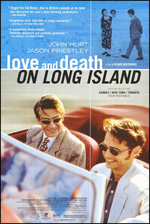| Music | Literature | Film | Index | About |

|
Love and Death on Long Island, Directed by Richard Kwietniowski Lions Gate Films, March 6, 1998 (UK/Canada) Screenplay: Richard Kwietniowski, based on the novella by Gilbert Adair Starring: John Hurt, Jason Priestley, and Fiona Loewi
In the Cut, admit one. You know, the one where Mark Ruffalo bares all. Giles: I have begun to engage in completely new subject matter. New to me at least. Henry (Gawn Grainger): Splendid. At our time of life, it’s good to tackle something new. I’ve considered golf, actually. Giles: I could almost say that it has brought me into contact with everything that I myself have never been. But that must be all for the time being, Henry. Henry: Marvelous. I’m rather intrigued. No, this isn’t E.M. Forster, but that is precisely the point. Beauty can rear its head anywhere, from the eloquent prose within the pages of Howard’s End to places far less obvious (even in guilty pleasures). Granted In the Cut is trash but there is a certain other kind of beauty to be found in Ruffalo's scene of scenes. I just saw the remake of Last House on the Left the other night and thought it was gripping. I will argue to my grave a hundred times over why the film Titanic is more than just box office candy, highlighted by that breathtaking visual of the doomed ship slipping slowly (at first) into its icy tomb. And why should I not reveal that Tobe Hooper’s The Texas Chain Saw Massacre is among my favorite films of all time, right up there with output of more decorated directors such as Ingmar Bergman or Stanley Kubrick? There is more to the secret of what stirs the soul than can or should ever meet the eye. Giles: If one has to have a theme, Henry, it would be the discovery of beauty where no one ever thought of looking for it. So I am captivated to watch a rather distinguished gentleman feed his increasing appetite for such Ronnie Bostock films as: Hot Pants College II, Tex Mex, and Skidmarks. I cringe with recognition at the rush of excitement he gets from clipping another photo from some teen rag like Tiger Beat, pasting it into a growing scrapbook. I can understand the euphoria and need that is generated by obsession, when one suddenly believes they have to learn everything there is to know about this exciting (sexy) new actor: 12 Monkeys is one of his favorite films/he smokes Dunhill Lights of Chesteron. Get a little closer still. Don’t mind if I do. Giles: Or is it not the case that when we are in the habit of viewing a film more than once […] A remarkable phenomenon presents itself. We see that what at first appeared to be accidental or unrehearsed becomes on subsequent viewings, an indelible part of the film’s texture. […] So the largely unrecognized art of film acting depends entirely on the ability of the actor, or indeed actress, to make everything about himself … or herself, equally permanent. When thus an actor is called upon to smile, he must try to select from a collection … a repertoire … a whole file of smiles as it were; naive, rueful, sly, sarcastic … and so on. Who, if they are being completely honest, has not felt the tingle of some impossible attraction, however unattainable the reality? Have I said too much? Giles: Dear God. What have I done? You asked me where I was today. I was … I was. . . . Giles: I went to the pictures. The cinema. The cinema. What do I have to gain in revealing so many dirty little secrets anyway? I know that my opinions mean very little and threaten to expose me as anything from a fool to a fraud. Yet, I stand firm in saying there is never any shame in being inspired, no matter the source. During a brief moment of clarity, I will admit that of course there is some surrounding shame, even danger, mixed into the equation. It is a line that should never be crossed. But the movie plays on and my eyes begin to deceive me. Nobody is here to stop me as I leap into the screen, straight into the arms of my one and only.
|
 |
||||||